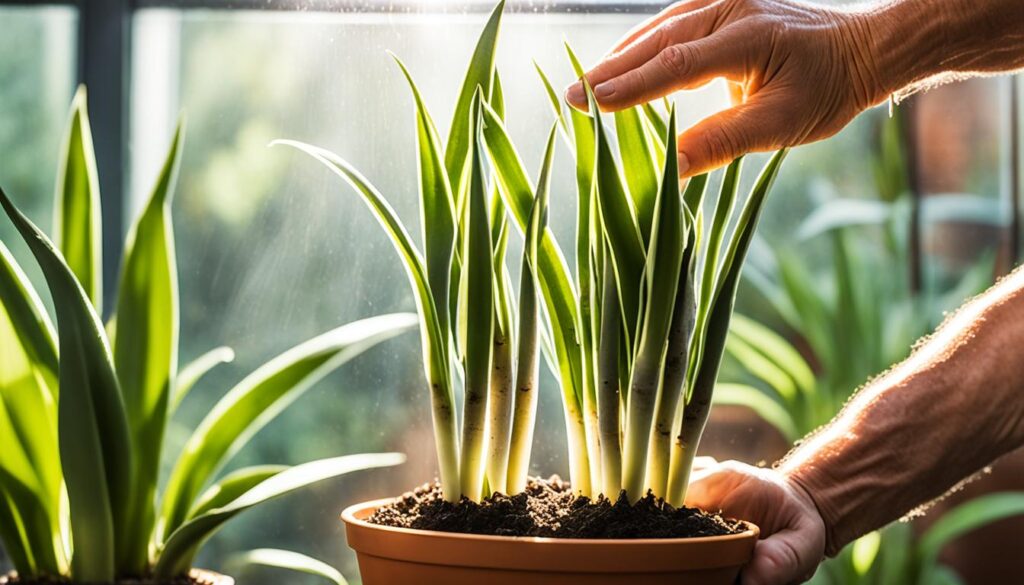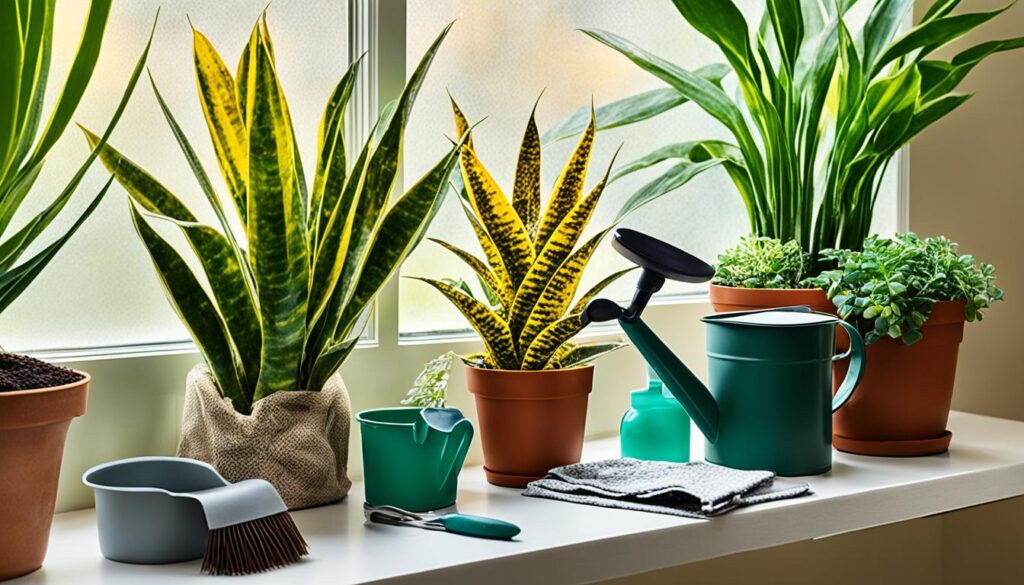Ever thought about multiplying your snake plant (Dracaena trifasciata)? Sharing its beauty with friends and family is easy and rewarding. Propagating snake plants is simple and can be done in several ways. This guide is perfect for both seasoned and new plant lovers. It will teach you how to easily propagate and care for your new plants.
Are you ready to begin? Let’s explore the exciting world of snake plant propagation together!
Getting Started with Snake Plant Propagation
Propagating a snake plant is a great way to grow your indoor garden and share it with others. It’s important to know the best time and tools for successful propagation.
When to Propagate a Snake Plant
The best time to start is in spring and early summer. This is when the plant grows the most. Try not to propagate in winter, as the plant is focusing on roots instead of leaves.
Best Time to Propagate a Snake Plant
Propagate in the early morning or late afternoon for the best results. These cooler times help reduce stress on the plant and increase success rates.
Essential Tools for Snake Plant Propagation
You’ll need a few key tools for propagation:
- Sharp knives, scissors, garden shears, or pruners
- A healthy snake plant leaf
- A planter or pot with drainage holes
- Well-draining potting soil
- Water
- A water-tight vessel (for water propagation)
With the right timing and tools, you’re set to successfully grow more snake plants and expand your garden.
How to Propagate Snake Plants: 4 Methods Explained
Propagating snake plants is rewarding and saves money. You can use several methods, each with its own benefits. Let’s look at the four main ways to grow these tough houseplants: snake plant soil propagation and propagating snake plants in water.
Snake Plant Soil Propagation
Soil propagation is a simple and effective way to grow new snake plants. Choose a healthy, mature leaf and cut it into 4-6 inch pieces. Make sure each piece has at least one leaf node. Let the cuttings dry and form a callus for a few days before planting them in well-draining soil.
Water them lightly and keep them in bright, indirect light. With time, the cuttings will root and grow into new plants. This will give you a brand new snake plant!
How to Propagate a Snake Plant in Water
For an easy method, try propagating snake plants in water. Cut the plant as you would for soil propagation. Then, put the cuttings in a clear glass or jar filled with water.
Place the container in a warm, bright spot. Change the water every week or two. As time goes by, you’ll see the cuttings grow strong roots. Once the roots are a few inches long, you can move the new plant to soil.
Choosing any snake plant propagation methods requires the right conditions and patience. With care and attention, you’ll soon have a collection of these easy-to-grow, air-purifying plants.
“Snake plants are one of the easiest houseplants to propagate, making them a great choice for both novice and experienced gardeners.
Caring for Your Propagated Snake Plant
Proper care is key for your snake plants to do well. Make sure they get the right soil, light, and temperature.
The Right Soil Mix for Your Snake Plant
Choose a potting mix that drains well, like a cactus/succulent mix with pumice or perlite. This mix helps with aeration and stops water from pooling. Snake plants need soil that drains well to prevent root rot and other problems.
Light and Temperature: The Sweet Spot
Snake plants love bright, indirect light and temperatures between 60-85°F (18-27°C). Don’t put your plant in direct sunlight, as it can make the leaves turn yellow and the tips brown. Be careful not to overwater, as this can cause root rot. Let the soil dry out between waterings and change the water every one or two weeks to keep it from rotting.

“Proper care and attention to the soil, light, and temperature requirements of your propagated snake plants will ensure their long-term health and success.”
Troubleshooting Common Issues With New Snake Plants
Seeing your new snake plant grow is exciting, but sometimes, you might run into problems. Don’t worry, with some troubleshooting, you can fix these issues easily.
Stunted growth is a common issue. It could be because of insufficient light, overwatering, or a lack of nutrients. Make sure your snake plant gets bright, indirect sunlight. Water it only when the top 1-2 inches of soil are dry. Adding a slow-release fertilizer can also help with growth.
Watch out for pests and diseases. Look for mealybugs or spider mites. If you find them, use neem oil or insecticidal soap to get rid of them. If you see signs of rot or other diseases, treat the plant with a suitable medicine and make sure it drains well.
| Issue | Possible Causes | Solution |
|---|---|---|
| Stunted Growth |
|
|
| Pests and Diseases |
|
|
By fixing these common troubleshooting issues with propagated snake plants, you can help your new plant grow strong and healthy. It will become a beautiful part of your indoor garden.

“A little TLC can go a long way in reviving a struggling snake plant.”
Conclusion
Propagating snake plants is a rewarding way to grow more or share with friends and family. This guide shows you how to do it through soil, water, division, or rhizome propagation. It’s both easy and cost-effective.
Make sure to give your new snake plants the right conditions. This means well-draining soil, bright indirect light, and the right amount of water. With patience and care, you’ll see your cuttings grow into healthy plants.
If you want more snake plants at home or to share them, this guide has you covered. It teaches you how to propagate and care for them. Happy propagating!
FAQ
What are the four main methods for propagating snake plants?
You can propagate snake plants through soil, water, division, and rhizome methods.
When is the best time to propagate a snake plant?
Spring and early summer are best for propagating snake plants. This is when they grow the most. Don’t propagate during the winter when they’re dormant.
What tools are needed for snake plant propagation?
You’ll need sharp knives, scissors, or pruners, a healthy snake plant leaf, and a planter with drainage holes. Also, use well-draining potting soil, water, and a vessel that won’t leak.
How do I care for my newly propagated snake plants?
Use a potting mix that drains well, like a cactus mix with pumice or perlite. Keep your snake plant in bright, indirect light and in a spot with a temperature of 60-85°F (18-27°C). Don’t overwater, letting the soil dry out a bit between waterings.
What are some common issues with newly propagated snake plants?
If your snake plant isn’t growing, it might not have enough light, be overwatered, or lack nutrients. Look out for pests like mealybugs or spider mites. Use neem oil or insecticidal soap to treat them. If you see rot or disease, use a suitable medicine to treat it and make sure the soil drains well.




Pingback: Dragon Scale Alocasia (Alocasia baginda 'Dragon Scale')
Pingback: Snake Plant, The Ultimate Low-Maintenance Houseplant for Beginners